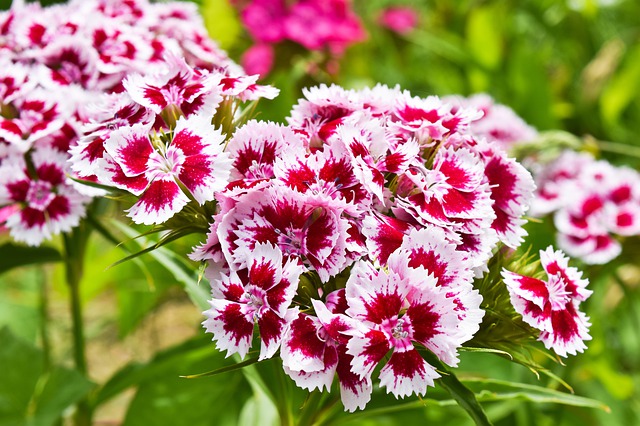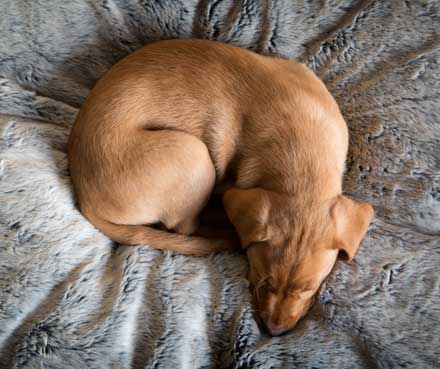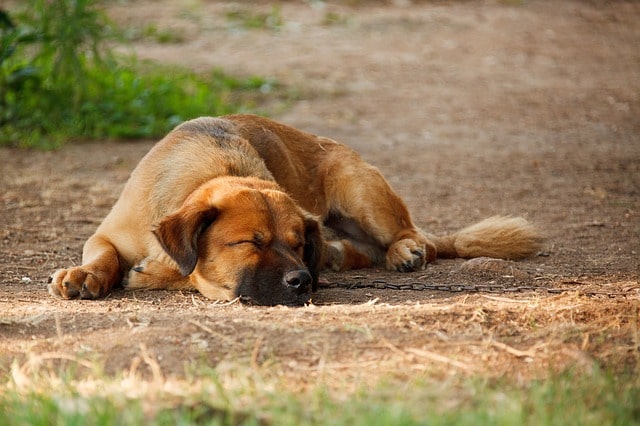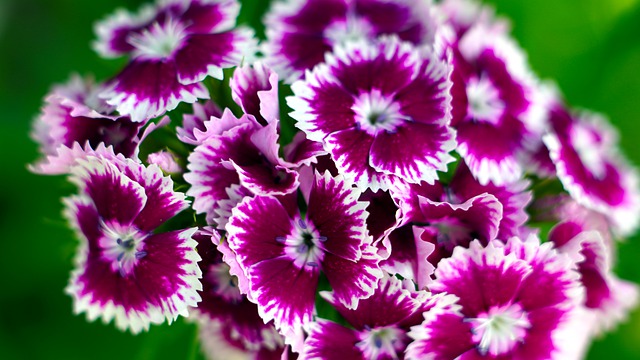Flowers add a touch of beauty and elegance to your space.
Whether you have potted ones around the house or in the garden, they can take your décor to the top.
Flowers also clean the air around the home and elevate your mood.
Unfortunately, if you have pets, you cannot just grow anything in your garden.
There are flowers that have been proven to be toxic to dogs, cats, horses, and kids.
Today, we will focus on one of most outstanding quintessential cottage flowers, the famous Dianthus. Is it poisonous to dogs?
Let’s investigate…
What is Dianthus?

| Scientific Name | Dianthus caryophyllus |
| Family | Caryophyllaceae |
| Common Names | Carnation, Pinks, Clove Pinks, Cheddar Pinks, Cottage Pinks, Maiden Pinks, Rainbow Pinks, Clove Pinks, Gillyflowers, Eastern Star, Sweet William. |
| Native Area | Asia, Europe, and Africa |
| Bloom Colors | Pink-Lilac, White, Deep Red, and Pink-Purple |
| Mature size | 4-36 inches tall; 4–24 inches wide (depending on the variety) |
| Plant Type | Grown as annuals, biennials, or evergreen perennials. |
Also known as Carnation, Clove Pinks, Cottage Pinks, Maiden Pinks, or Sweet William, the Dianthus is a family of flowers grown as annuals, biennials, or evergreen perennials.
Native to Asia, Europe, and Africa, it features strappy and grass-like foliage, which often occurs in shades of green, silver-green, or blue-green.
In the United States, they bloom in July-August with the seeds ripening in September.
The blooms may be single or double but all manifest the characteristic fringed-edged petals.
The blooms can be identified by their jagged-edged petals of different colors including pink-lilac, white, deep red, and pink-purple.
By the way, the nickname “pinks” shouldn’t confuse you, especially when you are choosing dianthus varieties for your garden.
While many varieties of this amazing plant do have pink flowers, the moniker comes from the jagged or fringed edges of its flower petals—which look like they were trimmed using ‘pinking shears’.
Their petals are often edible particularly if grown organically. They tend to have a similar taste as their smells with characteristic clove-like spiciness.
When crystallized with sugar, they can be used to decorate cakes. They can also be put in rice to add color and a bit of flavor.
But it is important to note that only the petals are edible—and not the leaves. The latter can cause mild gastrointestinal distress if consumed and mild dermatitis when touched.
Besides being used in cakes and cooking rice, the Dianthus is also featured in bouquets.
Is Dianthus Safe For Dogs?

While the flowers of the Dianthus flowers are bright and lovely, it is a rather toxic plant if ingested.
Both dogs and human beings suffer gastrointestinal upsets, skin irritations, and diarrhea when they consume the leaves of dianthus.
Human beings only suffer these issues if they ingest the leaves but dogs tend to react to every part of the plant (including the petals which are edible to humans).
The toxic variant that causes the mentioned reactions is still unknown.
However, there are speculations that its sap may be responsible.
The plant’s sap contains triterpenoid saponins that are believed to have mild toxicity toward dogs and humans
The saponins can cause vomiting and abdominal distress when consumed in small quantities and abnormal heart rate and seizures when consumed in copious amounts.
For starters, triterpenoid saponins are natural compounds that contribute to many plants’ protection against pathogenic microbes, fungi, and herbivores, thanks to their potent antimicrobial properties.
And yes, triterpenoid saponins have been isolated in many varieties of dianthus, including:
Signs of Toxicity

Different canines exhibit different symptoms of Dianthus poisoning.
Some of the common symptoms include the following:
- Lack of appetite
- Redness and itching of the skin
- Vomiting
- Diarrhea
- Skin irritation
- Abdominal distress
Learn also: Are Calibrachoa Poisonous to Dogs?
My Dog Ate Dianthus: What Should I Do?
Lucky for you, dianthus poisoning is not fatal to dogs for the most part.
So, your dog will not drop dead after munching some dianthus.
In fact, the toxicity symptoms we’ve listed above are considered mild and recovery typically goes very smoothly.
Nonetheless, if your pup ingests dianthus (or any other carnation variety), it is very responsible to take action for the sake of your Fido’s safety.
Here is what to do:
I. Remove the plant from your dog’s Mouth
If your dog is still chewing some parts of the dianthus plant, remove the remaining part from his mouth.
The STOP Command works perfectly in such situations. Remember to praise him to reinforce good behavior going forward.
Be sure to get any leftovers of the plant by flushing his mouth with clean, running water.
II. Call the Vet
After removing the remaining parts of the plant from your dog’s mouth, call your vet to brief him on the situation.
Most vets will advise you on the course of action to take—whether or not to induce vomiting, how to manage the situation at home, or whether to take the dog in for proper treatment and care.
If you can’t find your vet, reach out to Pet Poison Helpline (at 855-764-7661) or the ASPCA Animal Poison Control Center (at 888-426-4435). Expect to be charged a small fee for consultation.
III. Induce Vomiting
If your vet gives you the green light (this is bolded because it is important), induce vomiting by administering an emetic.
The easiest one is 3% hydrogen peroxide. The recommended dosage is one teaspoon for 10 lbs. of body weight administered orally.
After your fur baby vomits, be sure to rinse his mouth thoroughly again. In most cases, he will make a full recovery within a few hours.
You may want to read this: I Gave My Dog Hydrogen Peroxide And He Didn’t Vomit: What Does It Mean?
Caution:
Never attempt to induce vomiting unless instructed by your vet.
Vomiting may seem to be the right approach, especially if your dog is showing abnormal behaviors but it might also be dangerous depending on the amount of the plant your dog has consumed and what’s happening in his body.
IV. Take the dog to the vet
Excessive diarrhea, vomiting or severe skin irritation after your fur baby has completely expelled dianthus may indicate an allergic reaction or something serious going on in his system.
In such a case, rush the dog to the vet immediately.
Don’t wait or try any other home remedy you might have in mind at this stage because the treatment can be more complicated and expensive if the symptoms progress.
Since there are many species of dianthus, consider carrying a cutting of the exact plant your pup consumed.
This will help your vet in establishing the most appropriate medical diagnosis and treatment.
V. Get rid of the plant or restrict your dog’s access to it
As a preventative measure, you might want to get rid of the plant from the garden for the sake of your dog’s safety.
If that is not a possibility, look for a way of restricting the dog’s access to dianthus and any other poisonous plant in your garden:
- Surround the plant with something that can scare the dog any moment he comes close like loud pebbles.
- Spray the plant with lemon, vinegar, or a commercial deterrent.
- Fence the garden and secure it from your pet. The fence should be high enough that your fur baby will not get access to it no matter what.
- Educate yourself on non-toxic plant alternatives to add to your yard or garden.
Closing Thoughts
The Dianthus flower is a beautiful addition to any space.
Sadly, it is not safe around pets.
To keep your fur baby safe, consider doing away with it if you already have them in your garden or at the very least, create a barrier between your dog and the garden.
Going forward, consider knowing different plant species before adding any to your garden or yard.
This can go a long way in preventing any form of plant toxicity from happening in the first place.
Related Posts:
Are Astilbes Poisonous to Dogs?
Are Snapdragons Poisonous to Dogs
As an Amazon Associate, we may receive a small commission from qualifying purchases but at no extra cost to you. Learn more. Amazon and the Amazon logo are trademarks of Amazon.com, Inc, or its affiliates.

